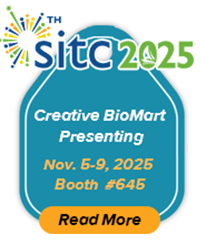| Species : |
Human |
| Source : |
Insect Cells |
| Tag : |
His |
| Protein Length : |
1-774 a.a. |
| Description : |
The FLT-4 cDNA encodes a 1298 amino acid (aa) residue precursor protein with a 23 aa residue signal peptide. Mature VEGFR-3/FLT-4 is composed of a 751 aa residue extracellular domain, a 22 aa transmembrane domain and a 482 aa residue cytoplasmic domain. Both VEGF family members VEGF-C and VEGF-D have been shown to bind and activate VEGFR-3/FLT-4. The Flt-4 gene is widely expressed in the early embryo but becomes restricted to the lymphatic endothelial a latter stages of development. It is important for lymphangiogenesis. All three VEGF receptors belong to the class III subfamily of receptor tyrosine kinases (RTKs) characterised by the seven immunoglobulin like loops in the extracellular domain. The expression of VEGFR-1 to -3 is almost exclusively restricted to hematopoietic precursor cells, vascular and lymphatic endothelial cells and to the monocyte/macrophage lineage. They play key roles in vasculogenesis, hematopoiesis, angiogenesis and lymphangiogenesis. |
| Subunit : |
Monomeric glycoprotein. |
| Purity : |
>90%, by SDS-PAGE and visualised by silver stain. |
| Endotoxin Level : |
<0.1ng per μg of sVEGFR-3. |
| Buffer : |
PBS. |
| Formulation : |
Lyophilized. |
| Biologically Activity : |
Measured by its ability to bind recombinant rat VEGF-C in a functional solid phase binding assay. Immobilised recombinant human sVEGFR-3/FLT-4 at 5μg/ml can bind recombinant rat VEGF-C in a linear range of 8-500ng/ml. |
| Reconstitution : |
The lyophilised sVEGFR-3/FLT-4 is soluble in water and most aqueous buffers. The lyophilised sVEGFR-3/FLT-4 should be reconstituted in PBS or medium to a concentration not lower than 100μg/ml. |
| Stability : |
Lyophilised samples are stable for greater than six months at -20°C to -70°C. Reconstituted sVEGFR-3/FLT-4 should be stored in working aliquots at -20°C. Avoid repeated freeze-thaw cycles! |



